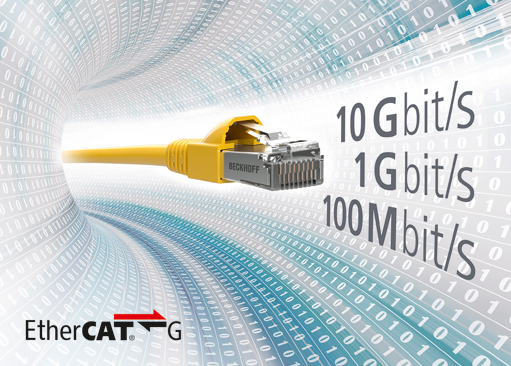EtherCAT G bygger på samme fundament som den opprinnelige EtherCAT-teknologien, men øker hastighet og datagjennomstrømning til 1 Gbit/s og 10 GBit/s. Protokollen er uendret, og gjennom et unikt «branch-controller»-konsept kan EtherCAT, EthetrCAT G og EtherCAT G10 fungere side om side i parallelle nettverkssegmenter. Alle EtherCAT’s verdsatte egenskaper som nettverksdiagnostikk, super-presis klokkesynkronisering (<<1μs!) og «process-on-the-fly» er ivaretatt. EtherCAT er i seg selv en svært rask protokoll, men ved innføring av EtherCAT G er det nå også tatt høyde for morgendagens krav til båndbredde og responstid. Ved å benytte EtherCAT G kan nettverksytelsen øket med inntil 700% avhengig av applikasjon! Prinsippet er det samme; alle slavene på nettverket mottar telegrammene som sendes ut fra Masteren. Slavene leser telegrammet «on-the-fly» og legger til sin egen informasjon ettersom telegrammet passerer forbi. Den eneste faktoren som forsinker telegrammet, er slavenes håndteringstid i hardware. Den siste slaven i segmentet benytter full duplex egenskapene til Ethernetstandarden og returnerer telegrammet til Masteren.
EtherCAT G supports standard Ethernet transmission rates of 1 Gbit/s; its EtherCAT G10 counterpart, already introduced as a proof-of-concept technology study, is even faster with data rates of 10 Gbit/s. The sharp increase in transmission rates beyond the standard 100 Mbit/s provided by EtherCAT significantly increases the possible data throughput. With propagation delay times through devices as a limiting factor on the one hand, but boosted by the newly introduced branch model on the other, EtherCAT G can deliver a two-to-sevenfold performance increase, depending on the application. Hans Beckhoff, the company’s Managing Director comments: “EtherCAT G and G10 raise performance to entirely new levels that will enable our customers to build the best, highest-performing machinery in the world! EtherCAT G and G10 are not meant to replace the highly successful EtherCAT standard based on 100 Mbit/s Ethernet. The new performance levels are intended as system-compatible expansions.”
Fully compatible enhancement, not a substitute for standard EtherCAT
Exceptional performance and ease of use have always been the hallmarks of EtherCAT. EtherCAT G shares the same characteristics, yet it achieves even higher transmission speeds without changes to the protocol or the EtherCAT master software. Fully compatible with the globally established EtherCAT standard, EtherCAT G provides the same field-proven capabilities, including built-in diagnostics, high-precision synchronisation and, most importantly, unrivalled telegram processing on the fly. It also conforms to the IEEE 802.3 Ethernet standard.
The high performance offered by standard EtherCAT remains more than sufficient for the majority of today’s applications. EtherCAT G has been developed specifically in anticipation of extremely large-scale applications and greater use of highly data-intensive equipment, such as machine vision cameras, complex motion control systems and measurement equipment operating with high sampling rates.
Branch controller model enhances variety of supported devices and minimises propagation delay
EtherCAT and EtherCAT G can be combined within a heterogeneous network. This means that EtherCAT G slaves can operate in a 100 Mbit/s EtherCAT network, and vice versa. In both instances, EtherCAT G equipment falls back to the 100 Mbit/s rate. With the new EtherCAT G branch controller model, though, EtherCAT branches can be set up to enable the parallel operation of 100 Mbit/s segments within a 1 Gbit/s network through a conversion of transmission rates. For instance, the new EK1400 EtherCAT G Coupler can create a branch that steps the data rate down from 1 Gbit/s to 100 Mbit/s, allowing the wide range of standard EtherCAT Terminals available to be used as I/Os on an EtherCAT G network. Based on the branch controller capabilities of the EK1400, the 1 Gbit/s data rate on the EtherCAT G trunk remains unaffected.
Another advantage of the EtherCAT G branch controller system is that it minimises propagation delays. The new CU14xx branch controller series is designed specifically to interconnect EtherCAT and EtherCAT G segments and enable parallel operation. This setup significantly reduces signal propagation times and, thus, shortens communication and cycle times, because telegrams coming back from a given segment travel straight from the branch controller to the master at the higher transmission rate of 1 Gbit/s, independently of other network segments.
Products

Kim Kiltveit
Beckhoff Automation AS
Raveien 205
3184 Borre
Norge
